Office real estate and industrial real estate in Vietnam both hold solid prospects, Savills Vietnam believes.
Demand for office space that meets sustainability standards has increased dramatically in recent times. Post-pandemic, tenants’ office selection criteria has changed towards prioritizing new buildings and focusing on “green” factors. According to Ms. Hoang Nguyet Minh, Senior Director of Commercial Leasing at Savills Hanoi, the strong shift in tenant demand has partly boosted competition between buildings, creating pressure on rents at old buildings that do not meet environmental criteria.
The greening of office buildings has almost become a necessity. Ms. Minh therefore noted that investors must have an investment strategy or renovate the office. Tenants also need to be prepared to adapt and locate premises in line with their expansion strategies as well as ESG (environmental, social, governance) commitments.
According to Savills’ Prime Benchmark report released in January, compared to other markets in the region, Hanoi and Ho Chi Minh City are in strong periods of development, along with Singapore, Seoul, and Taiwan (China). However, Grade A office rents are still low compared to elsewhere.
Grade A office rents in Hanoi are expected to continue to increase slightly thanks to new supply. Ms. Minh said the capital’s office market has welcomed notable projects such as Capital Place, 36 Cat Linh, and Taisei Hanoi Office Tower, so tenants still have many options for high-quality premises.
Industrial real estate, meanwhile, is also viewed as a bright spot in the market, attracting large volumes of foreign investment accompanied by sound potential and good absorption. According to the development plan for industrial parks (IPs) in Vietnam, there are now 563 IPs with a total area of 210,900 ha.
Commenting on the prospects for industrial real estate in 2023, Mr. Thomas Rooney, Senior Manager of Industrial Services at Savills Hanoi, said Vietnam’s economic risk index is currently lower than in other emerging markets such as Myanmar, Bangladesh, Laos, Cambodia, and Malaysia. Vietnam also continues to benefit from foreign investment, advantages in labor supply, and major export opportunities with China. Despite unfavorable geopolitical factors around the world, Vietnam’s economy is expected to continue to remain stable thanks to domestic consumption.
In addition to the positive prospects, however, there are still long-term challenges, especially for tenants, in terms of skilled workers and infrastructure. Mr. Rooney said Vietnam has a large workforce, many new manufacturing investments, and an economy that is moving up the value chain, but there remains a shortage of skilled workers. When attracting the attention of investors, the government therefore needs to ensure the quality of its workforce.
Compared to elsewhere in Southeast Asia, Vietnam has outlaid large sums on infrastructure development, representing 5.8 per cent of total GDP, but Mr. Rooney emphasized that projects on highways and ports need to be improved further.









 Google translate
Google translate